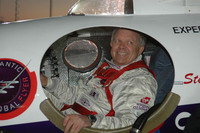Rescuers scan rugged terrain in California and Nevada in search for adventurer Steve Fossett
Calm winds and clear skies allowed rescuers to scan a vast swath of rugged terrain in California and Nevada on Wednesday in their search for adventurer Steve Fossett.

Friends and relatives, meanwhile, were counting on his grit and experience to pull him through. Fossett's single-engine plane vanished Monday as he was scouting dry lake beds for an attempt to set a world land speed record.
"He's the number one gliding pilot in the world, as well as the number one aviator in the world ... If anybody could have glided (this plane) down, it would have been him," Sir Richard Branson, the British billionaire who has helped finance many of Fossett's adventures, told reporters Wednesday. "But obviously, it's extremely worrying that it's lasted three days."
Branson said he and others were working with Google Inc. to study pictures from space that might help them determine the plane's direction and "whether there was anything unusual."
"If the worse comes to worse... Steve's lived his life to the full, and he hasn't wasted a minute of his life," Branson said.
The millionaire aviator did not file a flight plan. His plane, a Bellanca Citabria Super Decathlon, carried a locator that sends a satellite signal after a rough landing, but officials said they had picked up no locator signals from the plane or radio communication.
Even if the plane locator failed, Fossett usually wears a Breitling Emergency watch that allows pilots to easily signal their location, said Granger Whitelaw, co-founder of the Rocket Racing League.
"They're registered to us personally, so they know it's you," he said by phone Wednesday from New York. There had been no word of such a signal by Wednesday.
Rescuers in Nevada had higher hopes of finding something because there was little wind to interfere with their aerial search efforts, unlike Tuesday, said Gary Derks, operations officer for the Nevada Division of Emergency Management.
The aerial search Tuesday included 14 aircraft conducting grid searches over 7,500 square miles (19,425 square kilometers). The search on Wednesday was intended to concentrate on 600 square miles (1,554 square kilometers).
Fossett, the first person to circle the world solo in a balloon, took off alone Monday morning from an airstrip at hotel magnate William Barron Hilton's Flying M Ranch, about 70 miles (112 kilometers) southeast of Reno. A friend reported him missing when he did not return.
It was not known what kind of survival gear, if any, Fossett might have had with him. He was planning just a short flight before returning tothe privateair strip.
Civil Air Patrol Maj. Cynthia Ryan would not speculate about how many days someone might survive in the terrain, but she and longtime associates of the 63-year-old adventurer said he had proven survival skills.
"He's a very savvy and methodical and determined pilot. I'd give him the highest odds," she said.
Winds gusting up 40 mph (64 kph) on Tuesday kept the search planes from flying as low to the ground or as close to the 10,000-foot peaks as they would have liked, Ryan said.
One Civil Air Patrol pilot said turbulence was so bad that his aircraft dropped 1,500 feet (457 meters) in about three seconds. The downdrafts and gusts also provide a very real danger: They can come out of nowhere to push aircraft into the granite mountainsides if pilots are not careful.
"It's provided a real bouncy ride for our searchers and that makes it really difficult to look at what's on the ground," Ryan said.
Forecasters said the winds would drop to about 10 mph (16 kilometer) on Wednesday in the county Fossett had targeted.
Nevada National Guard planes and helicopters in the rescue effort were equipped with infrared and other high-tech vision equipment, said Col. Craig Wroblewski, the Guard's director of operations. The aircraft worked into the night Tuesday, but there was no sign of the pilot or his plane.
"We just want to find him alive," Wroblewski said.
Fossett has an application pending before the U.S. Bureau of Land Management for a permit in Eureka County to attempt to break the land-speed record of 766.6 mph (1,233.67 kph).
In 2002, Fossett became the first person to fly around the world alone in a balloon. In two weeks, his balloon flew 19,428.6 miles (31,265.85 kilometers) around the Southern Hemisphere. The record came after five previous attempts - some of them spectacular and frightening failures.
It is among dozens of firsts claimed by Fossett in his life as an adventurer, which he embarked on after earning a fortune as a financial trader.
He set marks for speed or distance in balloons, airplanes, gliders, sailboats - even cross-country skis and an airship, according to his Web site. In March 2005, he became the first person to fly a plane solo around the world without refueling.
Fossett also has experience as an outdoorsman, climbing some of the world's best-known peaks, including the Matterhorn in Switzerland and Mount Kilimanjaro in Tanzania.
He also swam the English Channel in 1985, placed 47th in the Iditarod dog sled race in 1992, participated in the 24 Hours of Le Mans car race in 1996 and broke the round-the-world sailing record by six days in 2004.
Subscribe to Pravda.Ru Telegram channel, Facebook, RSS!





